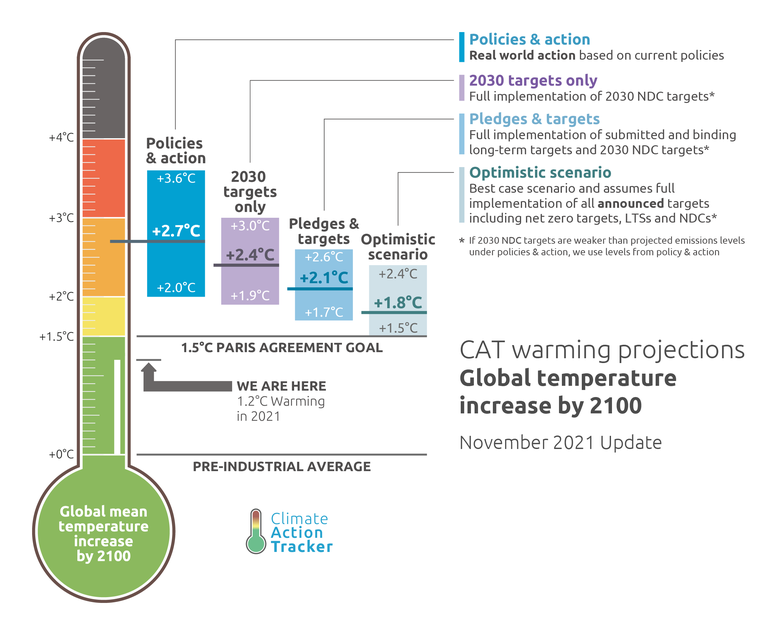Nature paper confirms CAT findings that with all pledges implemented we would be heading to below 2 degrees - but the reality does not yet match the rhetoric
CAT Blog
A paper published in Nature today about what level of warming we’re headed for gives a robust and comprehensive analysis of governments’ stated intentions, but there is a huge difference between government rhetoric and reality.
The paper (by Meinshausen et al.) confirms what we already know: if governments fully implement their pledges and in particular their long-term net zero targets (and this is a big “if”), we could reach temperature levels just below 2°C by the end of the century.
This is consistent with our Climate Action Tracker Analysis, released in Glasgow and the differences are largely due to what pledges are included, such as the announcements from India, Russia, Saudi Arabia and Turkey that have not yet been officially submitted to the UNFCCC, along with a few others under discussion and not yet agreed.
- The CAT’s “pledges and targets” includes only those pledges and targets officially submitted to the UNFCCC and calculates a mean end of century warming of 2.1°C (1.7-2.6). (see CAT thermometer below)
- The Meinshausen et al scenario includes all of the above plus India’s announcement and reaches 1.9°C
- The CAT’s “optimistic scenario” includes all of the above plus the announcements from Russia, Saudi Arabia and Turkey, and a few others that are under discussion, and reaches 1.8°C (1.5 to 2.4).
This also gels with the Climate Action Tracker’s September 2021 estimate, with similar conclusions, published in Nature Climate Change.
The difference in the analyses is that the new Nature paper does not check whether governments are making efforts to implement their long-term targets, and whether they are credible. The CAT considers the “currently implemented policies” analysis to be critical to our understanding of how government emissions are actually tracking in the real world. In our calculations, government current policies will put warming at 2.7˚C.
We know that governments are far from implementing their long-term targets and many, such as Australia which has been singled out by the UN Secretary General, have no policies in place to get there. No single large-emitting country has yet put policies in place to set emissions on a trajectory to meet its long-term, 2050 target. Government net zero targets are not part of their 2030 NDCs submitted to the UNFCCC, although some are contained in their submitted long term strategies (LTS).
Critically, sufficient 2030 action is lacking - this gap is profoundly reinforced in the recently-adopted IPCC WGIII report, which essentially said emissions are headed in the wrong direction and need to be turned round well before 2025.
The CAT and the new Nature paper agree that 2030 pledges alone (without the net zero pledges until 2050) lead to a much higher temperature increase: the CAT’s “2030 targets only” estimate of 2.4° estimate is comparable to the 2.2 to 3.0°C estimate of the new Nature paper.
Right now, governments are only pledging to stabilise global GHG emissions by 2030. This would mean that globally, we would be emitting twice as much in 2030 as we should be under a 1.5°C trajectory. Indeed, their currently implemented policies are not yet sufficient to meet these 2030 pledges. Without strong action by 2030, the net zero targets - and indeed the 1.8˚C (or “just below 2˚C) – let alone the Paris Agreement’s 1.5°C limit, are out of reach.
So while the long term net zero pledges are a good sign that governments have understood the ambition level they need to achieve, there remains a serious risk that many of these are simply greenwash and not backed by real policy commitment.
The spate of long-term net zero pledges by no means allows us to lean back and relax, because long-term promises need to be matched by short term action for 2030, which is the key focus of international climate action right now.
Stay informed
Subscribe to our newsletter
